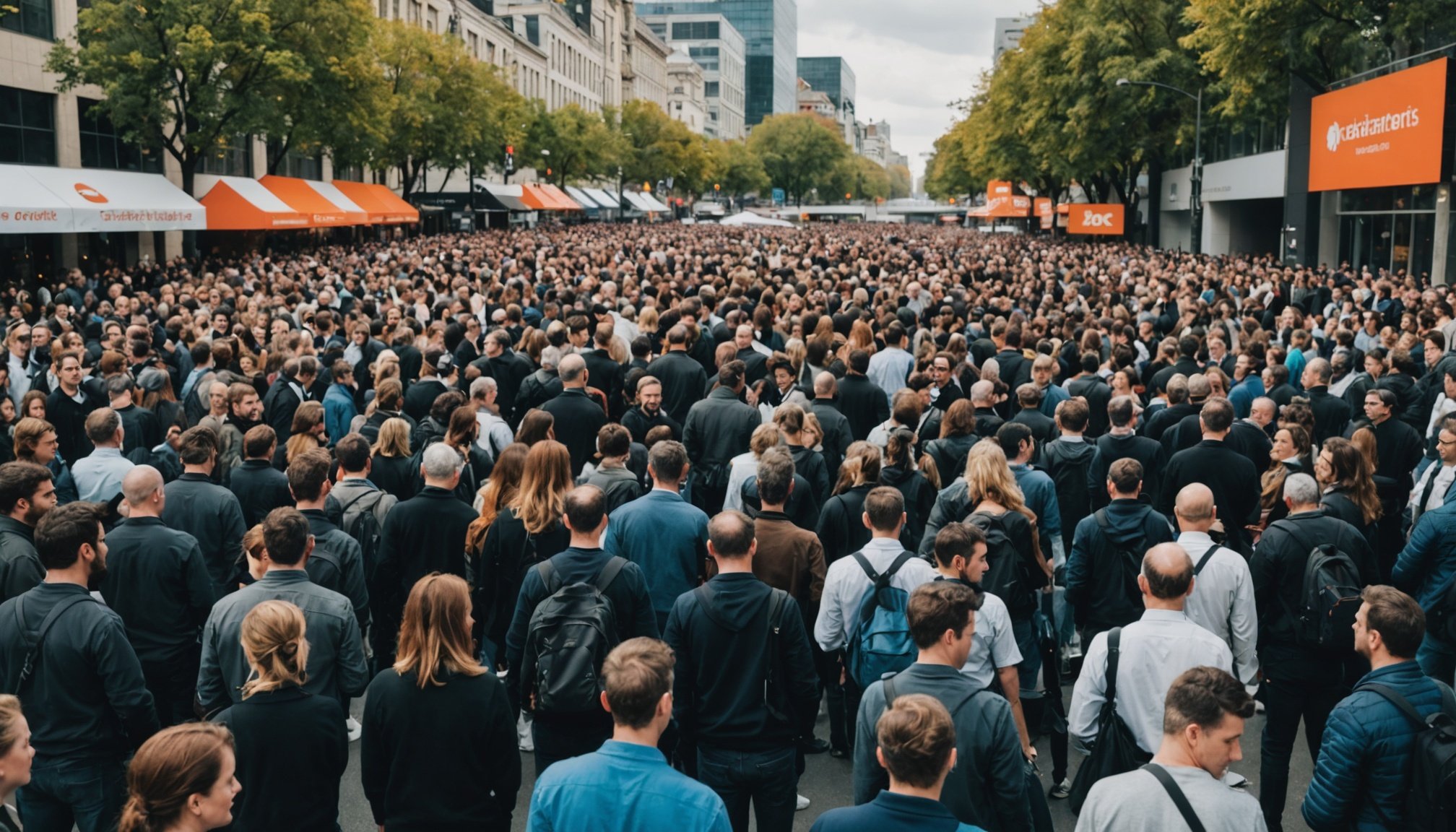Transforming Event Management: How Machine Learning Enhances Real-Time Crowd Control Solutions
In the vibrant and often chaotic world of event management, ensuring the safety, efficiency, and overall experience of attendees is a daunting task. However, with the advent of machine learning and artificial intelligence, event organizers are now equipped with powerful tools to manage crowds more effectively than ever before. This article delves into the transformative impact of machine learning on real-time crowd control solutions, highlighting its benefits, applications, and the future of event management.
The Need for Advanced Crowd Management
Managing large crowds is a complex challenge that has been exacerbated by the increasing size and diversity of events. The 2022 UEFA Champions League Final in Paris, for instance, saw overcrowding outside the stadium lead to significant delays, confusion, and safety concerns. Such incidents underscore the critical need for innovative and reliable crowd management strategies[1].
Topic to read : Unlocking the future of finance: how quantum computing is transforming cryptography for secure transactions
Role of Machine Learning in Crowd Management
Machine learning is revolutionizing crowd management by providing real-time insights and automated solutions that enhance safety, efficiency, and the overall attendee experience.
Real-Time Monitoring and Analysis
Machine learning algorithms can analyze video feeds in real-time, using advanced computer vision models to monitor movements, recognize patterns, and detect unusual behaviors. For example, systems like Ultralytics YOLO11 can accurately track individuals in crowded areas, focus on specific regions of interest, and generate visualizations such as heat maps to identify areas of high crowd concentration[1].
Also to discover : Explore exceptional notion templates for enhanced productivity
- **Crowd Density Monitoring**: Real-time tracking of crowd density to prevent overcrowding.
- **Behavior Analysis**: Identifying unusual behaviors to anticipate and mitigate potential risks.
- **Heat Maps**: Visual representations of crowd concentration to guide decision-making.
- **Automated Alerts**: Alerts sent to organizers when predefined crowd thresholds are exceeded.
Predictive Analytics and Forecasting
Machine learning models can analyze historical data, ticket sales, and real-time patterns to forecast transportation needs and crowd behavior. By incorporating data from various sources such as past event attendance, ticket scanning data, and social media engagement, these models can anticipate demand levels with remarkable precision. This predictive capability helps event organizers optimize resource allocation, vehicle fleets, and staffing, ensuring a smoother and more efficient event experience[3].
Applications of Machine Learning in Event Management
Machine learning is being applied across various aspects of event management to enhance the attendee experience, improve safety, and streamline operations.
Event Transportation and Mobility
AI-powered transportation systems use machine learning to analyze historical data, real-time traffic conditions, and weather updates to optimize vehicle routes and schedules. This dynamic routing approach ensures that attendees arrive on time with minimal disruptions. Additionally, predictive maintenance of vehicles reduces downtime, and the integration with smart infrastructure elements like smart parking solutions and automated check-ins further enhances the guest journey[3].
- **Dynamic Routing**: Adjusting routes in real-time based on traffic, weather, and other factors.
- **Predictive Maintenance**: Identifying potential vehicle issues before they escalate.
- **Smart Infrastructure Integration**: Coordinating with venue systems, traffic signals, and security checkpoints.
People Counting and Crowd Estimation
Advanced people counting systems, such as those offered by AxxonSoft, use machine learning to accurately monitor and analyze crowd dynamics. These systems can count groups of people within a specified area, generate alerts when thresholds are exceeded, and integrate with automated workflows to adjust environmental controls or initiate crowd management protocols. This technology is crucial for managing large gatherings in public events, transportation hubs, and retail spaces[2].
| Application | Description | Benefits |
|---|---|---|
| Public Events | Real-time crowd counting and density monitoring | Enhanced safety, optimized crowd flow |
| Transportation Hubs | Predicting peak times, optimizing passenger flow | Improved travel experience, reduced congestion |
| Retail Spaces | Analyzing customer behavior, managing staff allocation | Improved shopper satisfaction, strategic decision-making |
Enhanced Security and Surveillance
Machine learning-powered surveillance systems can enhance security by using facial recognition, emotion detection, and behavior tracking. These tools help identify potential security threats early, allowing for proactive intervention. For instance, the London Underground uses vision-driven crowd monitoring to keep passengers safe during busy times, demonstrating the efficacy of these technologies in real-world scenarios[1].
Challenges and Limitations
While machine learning offers significant advantages in crowd management, there are several challenges and limitations to consider.
Data Privacy and Security
The use of AI and machine learning in crowd management raises important questions about data privacy and security. Ensuring that personal data is protected and that surveillance systems are used ethically is crucial. Event organizers must implement robust data protection policies and transparent communication with attendees about how their data is being used[3].
Technical Infrastructure
The implementation of AI-driven crowd management systems requires robust technical infrastructure, including high-speed connectivity and edge computing capabilities. The integration of 5G networks, for example, can enable real-time data processing and faster communication, but it also necessitates significant investment in infrastructure[1].
Ethical Considerations
There are ethical considerations surrounding the use of AI in crowd management, particularly regarding the balance between safety and individual freedoms. Event organizers must ensure that the use of AI does not infringe on attendees’ rights or create a surveillance state atmosphere.
Future of Event Management with Machine Learning
The future of event management is increasingly driven by machine learning and artificial intelligence. Here are some key trends and innovations that are set to transform the events industry:
Integration with Smart Cities
AI-powered event management systems are being integrated with smart city infrastructure to create seamless and efficient event experiences. This integration includes smart parking solutions, automated check-ins, and real-time data exchange with venue management systems, security checkpoints, and environmental controls[3].
Autonomous Transportation
Autonomous transportation fleets are being introduced to enhance event mobility. These fleets can be quickly scaled up or down based on event requirements and communicate seamlessly with venue systems and smart city infrastructure, ensuring smooth and efficient guest transportation[3].
Sustainability and Efficiency
Machine learning is also helping event organizers achieve sustainability by optimizing resource allocation, reducing unnecessary vehicle deployments, and minimizing idle time. Advanced analytics provide clear visibility into operational costs, helping identify areas for efficiency improvements while maintaining high service quality[3].
Practical Insights and Actionable Advice
For event organizers looking to leverage machine learning for crowd management, here are some practical insights and actionable advice:
Start with Data Collection
Begin by collecting and analyzing historical data on past events. This data can include attendance figures, crowd flow patterns, and feedback from attendees. Machine learning models rely on robust data sets to make accurate predictions and recommendations.
Invest in Advanced Technologies
Invest in advanced technologies such as computer vision models, predictive analytics tools, and smart infrastructure solutions. These technologies can provide real-time insights and automate many aspects of crowd management.
Ensure Transparency and Ethical Use
Ensure that the use of AI and machine learning is transparent and ethical. Communicate clearly with attendees about how their data is being used and ensure that data protection policies are in place.
Collaborate with Experts
Collaborate with experts in AI and machine learning to implement these technologies effectively. This includes training neural networks based on specific site and task requirements to maximize results.
Machine learning is transforming the landscape of event management by providing real-time crowd control solutions that enhance safety, efficiency, and the attendee experience. From real-time monitoring and predictive analytics to advanced surveillance systems and autonomous transportation, the applications of machine learning are vast and promising.
As the events industry continues to evolve, embracing these technologies will be crucial for event organizers who want to stay ahead of the curve. By understanding the potential of machine learning and addressing the challenges associated with its implementation, we can create smarter, safer, and more enjoyable events for all attendees.
In the words of a leading expert in the field, “The integration of AI and machine learning into event management is not just about technology; it’s about creating a better experience for everyone involved. It’s about ensuring safety, optimizing resources, and making every event a success story”[1].
As we look to the future, it’s clear that machine learning will continue to play a pivotal role in shaping the events industry. Whether it’s through predictive analytics, real-time monitoring, or advanced surveillance, the possibilities are endless, and the benefits are undeniable.











